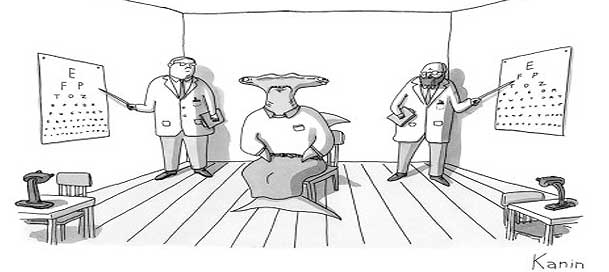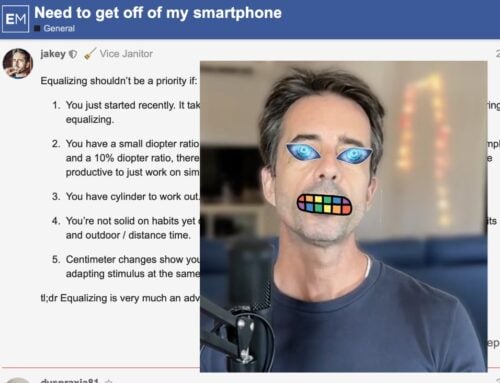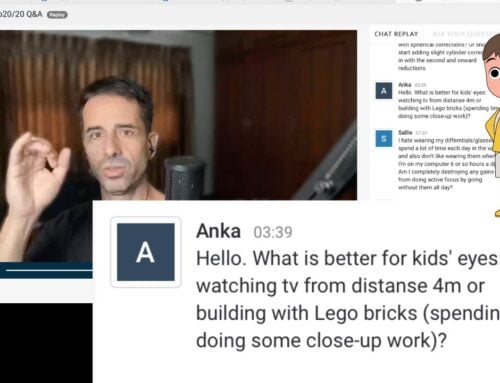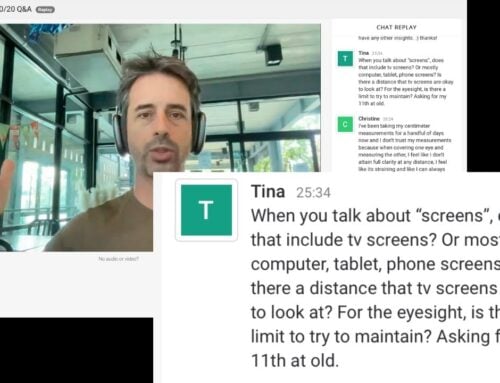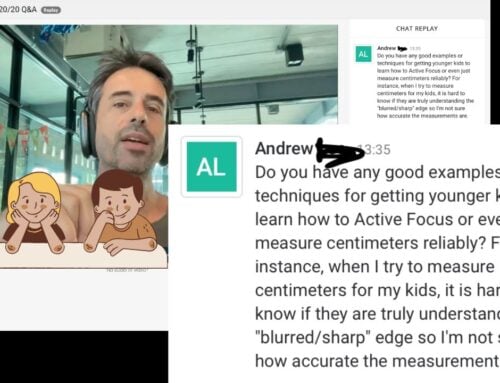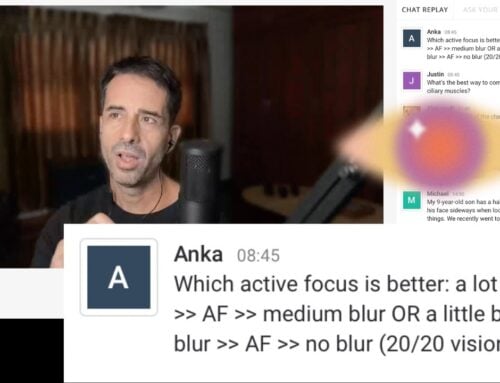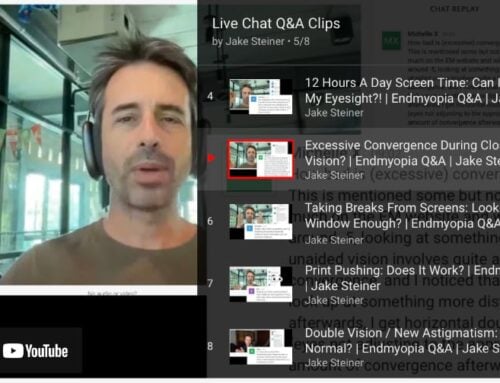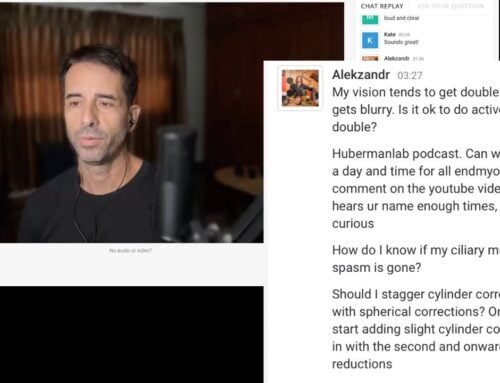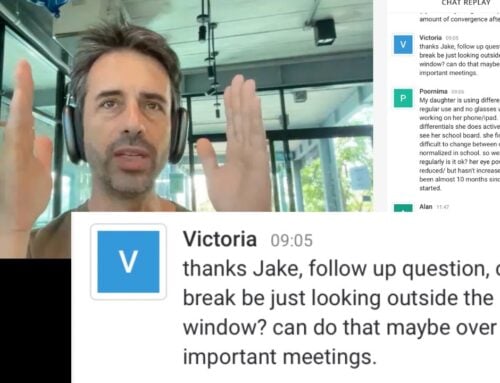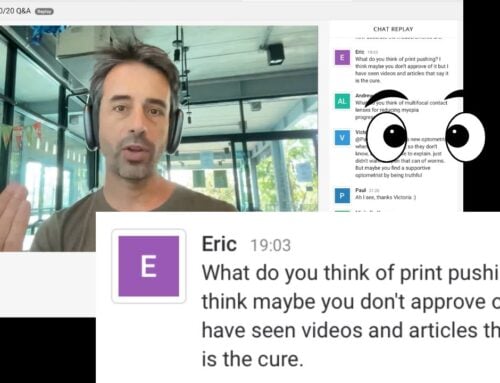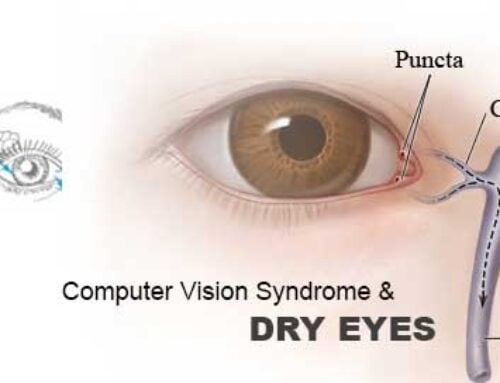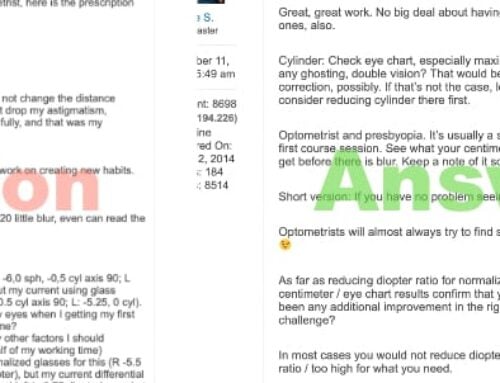It’s not unusual for me to spend about as much time on a single forum question as I do on an entire post here for the blog.
No wonder you say, Jake, that the blog is such a wind blown shack then.
You get what you pay for. That’s why I only do 10 invites every month, otherwise I’ll end up completely fretting about whether I’m providing decent support. That’s why you see consistent low volume of support requests in the forum, because I look at every one of them and think about how the sessions could address the questions, before they even happen. Tweaking, based on feedback.
Here’s two examples (and good Q&A material) from today’s forum questions.
1. John & Many Glasses & Astigmatism
John has presbyopia and myopia, and has a pile of different correction strength glasses. He also has astigmatism well over a diopter, which he doesn’t use correction for. He’s just a few weeks into the program, and wondering what he should use for distance correction.
I’ll skip John’s post details here, and let’s look straight at my suggestions:
Hi John,
What kind of lighting do you use with the eye chart tests?
A few other notes:
1. Focal Planes
I structure the program to be as much positive-only, “do this and you’ll make good progress” experience, as possible. Meaning, all the “don’t do this”, things we’ve tried and discarded, things that would be counterproductive, none of that is mentioned. The goal is to make it BackTo20/20 simple, confidence inspiring, streamlined as possible. Elegance in simplicity, all that. ?
What you notice as you go through it, is that we make very, very few focal plane changes, and they’re always ‘stacked’ in a way to leave a 4-6 week gap at the very least, between changes. The program is also very restrained about multiple focal plane changes, addressing astigmatism, and diopter ratio (left vs. right eye spherical).
Reason for all this is that your visual cortex responds positively to a well placed focal plane change, but increasingly poorly as you introduce multiple changes, especially in short order or repeatedly, or even multiple changes at once.
Long story short, resist the urge to change lenses more than the program suggests (at least for the first few months, to give the program a chance to show it’s full effectiveness potential).
2. Astigmatism
I like to get rid of diopter complexity, generally speaking. A simple focal plane is much easier to modify and adapt to. That said, often just starting out it’s ideal to make the stimulus as simple as possible. That might mean a small spherical reduction (leaving alone cylinder correction), find active focus, practice active focus, see measurable progress. It’s important for confidence, as well as to prime the biology to keep following that stimulus.
Now if you read the blog a lot, you might already know much of this.
And also, this is one of the issues with providing a myopia control solution to such a wide range of an audience. John is coming in with a scenario that’s much different from many others, and we need to address some of those things.
You don’t want to ignore astigmatism over a diopter. You want to test first if you’d benefit from that correction, make an informed decision, and if need-be use the astigmatism correction to get you some good spherical reductions as a start.
Makes sense in hindsight, but if you didn’t know, you save a lot of time if you’ve got somebody to tell you.
Likewise, messing with focal planes. That’s one of the big no-no’s in Jakey’s book. Your visual cortex isn’t designed to expect and manage focal plane changes. That’s the eye’s job and it has an incredibly complex (and fascinating) control mechanism to deal with focal planes (and manage axial change). So when you leave the visual cortex with the wrong (and frequently changing) focal planes, you’re really messing with your biology in a way that’s going to be highly counterproductive.
We’re like children playing with a spaceship, the way we are using plastic lenses to change focal planes to produce clear vision.
So if you don’t know, you just use the program and it’s all really simple (too simple, some say). What makes it so cool is what it doesn’t do though, potential mistakes like the ones we just looked at. It’s really easy to get your eyes back, if you know how!
(John’s thread here)
2. Val & Double Vision
Val asks:
Like what the hell is going on with my brain?! Do I need to actively fix it or will my visual cortex eventually pick up its end of the bargain? Other good names: ghost vision, active blur :), blur film vision, double plus floating vision…
I’ve been doing a lot of my active focus work without glasses (my far seeing glasses are -7, and my close ups are -5.75). I see what I once called 20/85 (text in focus, but a strong blur all around).
I’ve also been doing this no-glasses active focus on non text for the past month or two. I feel like it’s working.
And this is one the program is designed to account for, when most students start to notice the slight nuance between what’s just blur, vs. what’s actually multiple fragments of a clear image, which don’t align properly (just yet).
Here’s what I explain to Val:
Ha! ? So the progression of improving eyesight is not really blur > clear, but rather blur > double vision > clear (for the most part).
The best we can interpret, first changes happen in your eyeball (ciliary muscle, axial change), and then the visual cortex has to ‘recalibrate’ to the changes in focal plane, accounting for small inconsistencies in changes in left and right eye, and in the individual eye focal plane signal. The sessions get into this in a bit, discussing clearing double vision.
Takes a while, and it’s not like active focus. You just stare at larger and smaller fonts (ideally), like a newspaper headline and sub text (or billboard, those are good). Let the big text clear up, then the little text is clear too. It’s not really a distance dependent experience like active focus, and it’s more about almost meditative, passive, just looking and waiting, as opposed to the “active” focus activities where you blink and try to ‘will’ things to clear up.
Here again, if you’re an avid blog reader, you may already know this.
(Val’s full post)
That’s the whole trade. Read all of the blog, know most of the things you need to know. Don’t want to spend the time, then pay for my time to dig out just aspects relevant for you, whenever you encounter them. It benefits me since it allows me to continue to fine tune a structured method to improve eyesight, and it benefits you because you can just ask the eye guru directly, instead of spending hours digging around the blog.
Housekeeping: Speaking of digging, I had invites turned off since the start of the month, till about two days ago. I didn’t mention this anywhere Apologies, if you got teased and then didn’t get an invite. It’s been a bit busy with my business things, and it was nice to get a little breather here.
Back on now, though mostly all taken already. I gave out a few to those who asked what was going on, and made a good case for a little preferential treatment. ;)
Cheers!
-Jake

